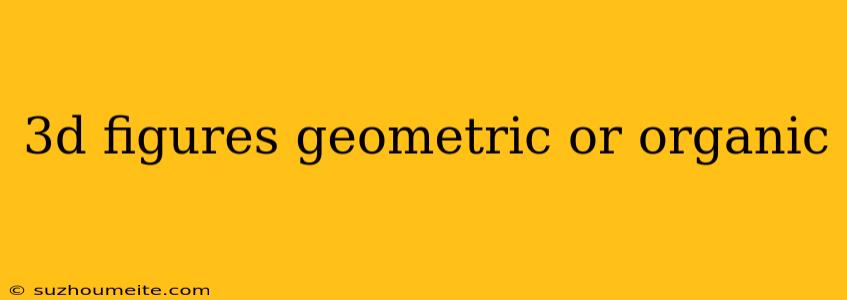3D Figures: Geometric or Organic
In the realm of 3D modeling, figures can be categorized into two main types: geometric and organic. These two categories differ in their characteristics, uses, and design principles. In this article, we will delve into the world of 3D figures, exploring the differences between geometric and organic shapes, and their applications in various fields.
Geometric Figures
Geometric figures are characterized by their precise, mathematical structures. They are composed of simple shapes, such as points, lines, and curves, which are combined to form more complex structures. Geometric figures can be further divided into two subcategories: Polyhedra and Curved Surfaces.
Polyhedra
Polyhedra are three-dimensional solids with flat faces and straight edges. Examples of polyhedra include the cube, tetrahedron, and octahedron. These shapes are often used in architecture, engineering, and product design, where precision and accuracy are crucial.
Curved Surfaces
Curved surfaces, on the other hand, are geometric figures with smooth, continuous curves. Examples include spheres, cylinders, and cones. These shapes are commonly used in industrial design, automotive design, and medical device development, where smooth curves are essential for aesthetics and functionality.
Organic Figures
Organic figures, also known as free-form surfaces, are characterized by their irregular, curved, and often unpredictable shapes. These figures are often inspired by nature, with shapes that resemble living organisms, such as flowers, animals, or clouds. Organic figures can be further divided into two subcategories: Biological and Abstract.
Biological
Biological shapes are inspired by living organisms, such as animals, plants, or microorganisms. These shapes are often used in fields like biology, medicine, and zoology, where accurate representations of natural forms are essential.
Abstract
Abstract shapes, on the other hand, are organic figures that do not resemble any specific natural form. These shapes are often used in art, design, and architecture, where creative freedom and expression are valued.
Applications and Uses
Both geometric and organic figures have numerous applications in various fields, including:
Computer-Aided Design (CAD) and Computer-Generated Imagery (CGI)
Geometric figures are essential in CAD and CGI, where precision and accuracy are crucial for designing and visualizing complex models.
Art and Design
Organic figures are often used in art and design, where creative freedom and expression are valued.
Medical and Biomedical Applications
Both geometric and organic figures are used in medical and biomedical applications, such as modeling organs, tissues, and devices.
Gaming and Virtual Reality
Geometric and organic figures are used in gaming and virtual reality, where detailed and realistic models are essential for immersive experiences.
Conclusion
In conclusion, 3D figures can be broadly classified into geometric and organic categories. Geometric figures are characterized by their precise, mathematical structures, while organic figures are known for their irregular, curved shapes. Both categories have numerous applications in various fields, and understanding their differences is essential for effective 3D modeling and design.
